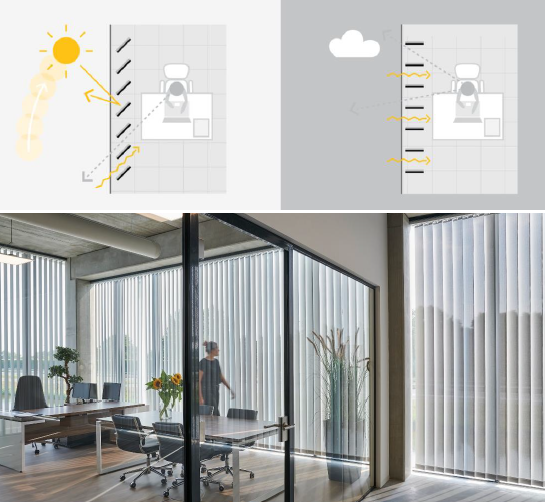Information
| EngD trainee | Oindrila Ghosh |
| University supervisor | dr. ir. R.C.G.M. (Roel) Loonen |
| Company supervisor | ir. Sam Kim |
| Name of company | Kindow |
| Period of project | Mar 2019 – Feb 2021 |

Summary
There is an increasing awareness of wellness and health in office and public spaces in the building industry. Research has proven the importance of daylighting in offices and hence the increase smart use of solar shading systems is observed. Also increasing construction of fully glazed high rise buildings is the current architectural trend all over the world with little regard to the local climate context. This has resulted into an influx of daylight into office spaces thereby creating a need to be able to dynamically control the amount of light and heat entering the building. There is a plethora of shading systems available in the market that closes or opens according to a specific sensor threshold or they can be manually overridden by the occupant of the office space. This still not efficient and smart and doesn’t improve the quality of the indoor comfort. This is where my project company – Kindow comes in. It is an indoor shading solution and it has two product lines Roller shades and Vertical blinds. Kindow’s shading systems sense outdoor sky conditions and utilizes an advanced sun tracking algorithm to modulate the amount of heat and light that enters the space to provide optimal visual and thermal comfort. Mention sun track and reflective properties of the fabric
But there are a few problems that Kindow faces as an innovative solution in the solar shading market. They can be categorized as follows:
- Lack of research in terms of its performance evaluation in varying practical operating conditions as well as benchmarking its operational performance with other available products. Are their possibilities of improving on the current control strategies?
- There are thumb rules in the AEC industry like “only exterior shading is useful, because it can actually keep the sun out”. Are these assumptions still hold true? Such anecdotal assumptions also greatly hinder market integration for innovative solutions like Kindow.
- It is an integrated system where glazing properties in combination with shade material properties will affect overall performance for varying building design. How can this be co-optimized so that Kindow can better suggest its client on combinations of glazing and lighting with Kindow products for optimal visual and energy performance of the indoor space.
So, these problems that currently Kindow was dealing with became the main objectives for my PDEng project. The way I began approaching this problem was by first assessing Kindow’s existing operational performance using a complex co-simulation framework developed by our research group - Building performance and Simulation. This was then followed by providing solutions on three categories as follows:
1. Kindow’s own strategic research and development: I carried out simulations for Kindow products for varying client scenarios like changing location and direction and they were compared against products available in the market like a dynamic blind using solar irradiance as a sensor threshold. These studies illustrated that Kindow shades are atleast 23% more energy efficient than their conventional indoor counterparts. Furthermore, it also leads to the development of different control strategies for both roller shades and vertical blinds. For roller shades it was in response to changing façade orientation. Whereas for blinds they were in response to occupancy schedules.
2. Myth breakers: The existing thumb rule that external shades are better than internal shades were found to not always hold true! I did a small test using Kindow Roller blinds which simulated an office model with a South facing façade and a window to wall ratio of 80. In order to compare and benchmark the performance of Kindow Rollerblinds, the following case studies were considered.
- Case 1: External roller shades with reflective material properties.
- Case 2: External roller shades with non-reflective material properties.
- Case 3: Internal roller blinds with reflective material properties.
- Case 4: Internal roller blinds with non-reflective material properties.
- Case 5: Internal roller blinds with the Kindow control strategy.
Cases 1 to 4 are the baseline cases which are chosen in such a way to represent the performance of conventional automated shading systems available in the market. Case 5 uses the same reflective shade material as case 1 and 3, but with the advanced Kindow control algorithm. A careful combination of shade materials with reflective properties and the Kindow control strategy can lead to 6.5% energy savings compared to external shading systems.
3. Final Database for Client consultation: In order to solve the third problem for Kindow a client database is being created where various cases with varying input parameters such as Glazing properties, shade material properties, lighting , heating and cooling efficiencies etc are being simulated under varying scenarios of WWR, location and orientation. These simulation results will help Kindow to easily estimate it operational performance when a client comes in with its project specific requirements and suggest the optimal combination of glazing and shading properties allowing for better client consultations.